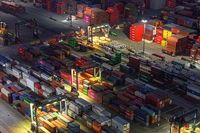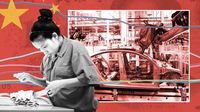In a rapidly evolving economic landscape, China is grappling with the consequences of increased automation and declining employment in traditional manufacturing sectors. The shift towards automation has created significant pressure on low-skilled workers, marking a profound transformation in the country's industrial framework.
A decade ago, Zhou Yousheng's shoe factory in Guangdong province stood as a beacon of China's manufacturing prowess, employing over 100 workers. At that time, China commanded over 70% of the global footwear export market, a staggering figure that underscored its dominance in low-value manufacturing. However, over the past ten years, Zhou has witnessed a dramatic decline in his business, driven by fierce competition from other countries, a trade war with the United States, and weakening domestic demand.
As wages in southern China have steadily increased, the cost advantage that once propelled China's manufacturing sector has diminished. Meanwhile, competitors in Southeast Asia, particularly Vietnam and Indonesia, have emerged as formidable challengers, offering lower production costs and more agile supply chains. Consequently, China's export market share has shrunk by 10% in the last decade, with Zhou's factory now employing fewer than 20 workers—a stark contrast to its former glory.
From his showroom in a nearly deserted wholesale market near Guangzhou, Zhou expressed his despair: "The future looks bleak and hopeless if this continues. It's hard to return to the days when everything was easier and the market was always open." This sentiment resonates with many small factories across China, which face a critical juncture: either invest heavily in automation or risk being phased out of the market.
According to researchers from Changzhou University, Yanbian University, and Henan University, employment in 12 labor-intensive manufacturing industries in China decreased by about 14% from 2011 to 2019, equating to nearly 4 million jobs lost. The textile industry alone saw a staggering 40% reduction in labor during the same period. Further analysis by the Financial Times revealed that an additional 3.4 million jobs disappeared from these sectors between 2019 and 2023.
Frederic Neumann, Chief Asia Economist at HSBC, noted, "For decades, China leveraged its competitive advantage with a plentiful labor force… and truly became the world’s leading manufacturer of labor-intensive products. But now, that game is over. The advantages that once helped China dominate are gradually eroding due to both domestic and external factors."
In a paradoxical twist, China now faces its own version of the "China shock"—a term used to describe the economic upheaval experienced by developed nations when manufacturing jobs shifted to China after its accession to the World Trade Organization (WTO) in the early 2000s. As production migrates to more affordable and efficient factories in Vietnam, Indonesia, and other Southeast Asian countries, the impact on China's labor market is profound. Exports from Vietnam and Indonesia have surged, with annual growth rates of 8.2% and 12.3%, respectively, from 2019 to 2023, creating a combined total of 10 million manufacturing jobs since 2011.
China is steadily losing ground in labor-intensive industries such as furniture, luggage, toys, and household products. In response, President Xi Jinping has emphasized that "new quality productive forces"—high-tech manufacturing—will be central to the country’s economic growth. However, analysts caution that this shift towards high-tech production is less labor-intensive and will not create sufficient jobs to absorb the surplus labor from traditional sectors.
Neumann emphasized, "High-tech production requires machines, robots, and automation, not millions of manual laborers. You won’t be able to employ as many people as before, that’s for sure." Experts are increasingly skeptical that manufacturing alone can help China achieve its ambitious 5% economic growth target for 2025.
The decline in traditional manufacturing jobs poses not only economic challenges but also risks of social instability. Increasing unemployment rates in certain regions could undermine overall economic prospects and create tensions that Chinese policymakers—accustomed to decades of rapid growth—have never faced before. Low-skilled migrant workers, who often move from rural areas to major cities for factory jobs, are particularly vulnerable during this transition.
Professor Gordon Hanson from Harvard University highlighted the potential consequences of manufacturing decline, citing Martinsville, Virginia, as an example. Once dubbed the "sweater capital of the world," Martinsville saw approximately 45% of its working-age population employed in manufacturing in 1990. However, as factories closed or relocated to China, most of those jobs disappeared, leaving the town unable to reposition its economy. Consequently, Martinsville now has a poverty rate double the national average.
Hanson remarked, "I expect there will be a significant difference in China compared to the U.S. The Chinese government will likely implement stronger efforts to prevent disruption, thanks to its centralized control and abundant resources." Nevertheless, he warned that if China expects to dominate both green technology and artificial intelligence while managing disruptions in traditional manufacturing, it may face painful lessons similar to those experienced by other nations.
Recognizing these challenges, the Chinese government is attempting to support traditional manufacturing during this transition. A notable example is Wang, a 40-year-old man who traveled nearly 2,000 kilometers to find work in the garment industry in southern China in February 2025. He arrived at Zhongda Fashion and Technology City, a joint project aimed at building a "smart manufacturing base" for the fashion industry.
Similar projects are being implemented across China to upgrade infrastructure and encourage technology adoption. At a factory in Panyu, Guangzhou, new electric vehicles are produced every 53 seconds, showcasing the integration of automation in manufacturing processes. However, the presence of human workers is steadily decreasing. Engineer Li Xiaoyu noted that the automation rate in final assembly has reached about 40%, with plans to reduce the workforce by 10% annually.
Li acknowledged a significant challenge: attracting young workers. "China now resembles Europe: it’s very hard to find young people to hire," he explained. The working-age population in China peaked at over 900 million in 2011 but is projected to decline to around 700 million by mid-century. This demographic shift, combined with changing attitudes among younger generations, is forcing policymakers to view automation and robotics as essential solutions for maintaining the country’s long-term manufacturing capacity.
However, automation is not a panacea. While it addresses labor shortages in some advanced industries, it also risks rendering millions of low-skilled workers obsolete. A study by Dorien Emmers and Scott Rozelle from KU Leuven and Stanford University found that the rapid upgrading of China's industry, coupled with a strong wave of automation, is diminishing demand for unskilled labor. As a result, wages for this group have stagnated or even decreased, a rare phenomenon in China's decades of continuous growth.
With a high rate of untrained labor, China faces an increasing risk of economic and social disruption. Emmers and Rozelle cautioned that wage declines could weaken consumer demand, ultimately hindering overall economic growth. "This will eventually lead to serious social issues such as higher unemployment rates, increased crime, and social instability," they wrote.
Despite tight state control, China is not immune to social tensions. Small-scale labor protests—often related to disputes between workers and employers—occur regularly across the country. According to the China Labour Bulletin (CLB), 2024 saw 452 protests in the manufacturing sector, the highest in nearly a decade. These protests stemmed from factory closures, production relocations, and prolonged wage arrears.
Han Dongfang, founder and director of CLB, noted a rise in collective worker struggles, particularly in electronics and garment manufacturing, as the economy transitions from low to high technology. In Kanglu, a garment manufacturing suburb in Guangzhou, a local labor market operates at less than 20% capacity, with older workers struggling to earn even 100 yuan a day.
As China navigates this complex transition, it faces both opportunities and challenges. The lessons learned from the past may hold the key to shaping a resilient future amidst the relentless march of automation and globalization.






